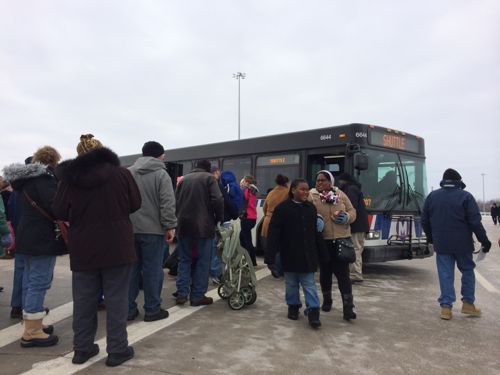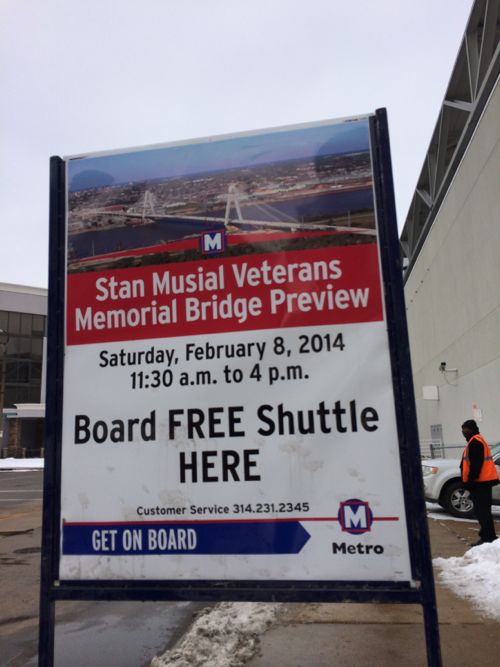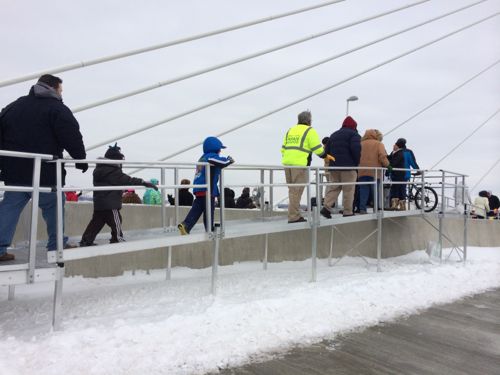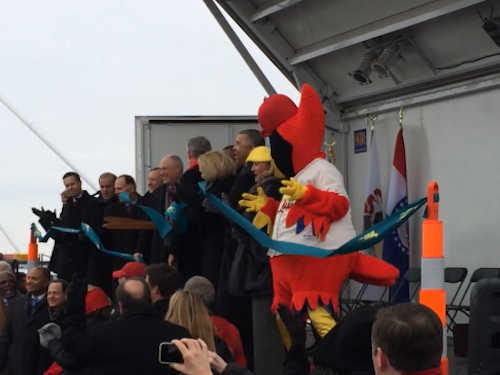Accessing the Opening of the Stan Musial Veterans Memorial Bridge
Despite the cold weather thousands came out Saturday to see the new Stan Musial Veterans Memorial Bridge a day before it opened to vehicle traffic. The shuttle we rode from 9th near Washington onto the bridge was packed tighter than the #70 Grand bus during peak use. I overheard some saying how nice the bus seamed, likely their first time on a bus. Our shuttle passed by the last two stops because we couldn’t take on another passenger.


As we approached I wondered if there would be a break in the center dividing wall to get from the westbound lanes to eastbound lanes. There wasn’t, instead the had ramps to cross over.

I don’t have any stunning bridge photos, it was too cold & gray to attempt. We did stay through all the speeches at the ribbon cutting.

I look forward to driving across the bridge, and seeing it night. This is an interesting example of a very cost-effective structure type also being very beautiful, sometimes limited budgets can result in a better finished product than unlimited budgets.
Hopefully any new development at each approach will be worthy.
— Steve Patterson
I went Saturday. Luckily I live within reasonable walking distance so I walked over. I did see a lot of people disappointed when the shuttle passed them. But the entire event was great and so is the bridge. Unfortunately I don’t see anything other than typical highway exit development (truck stops, fast food, etc.) here due to the almost-complete destruction of the urban fabric in this area over the past few decades. But I guess anything is better than a bunch of vacant lots.
It will be interesting to see what happens with development… it sure is a clean slate around Cass. McKee supposedly is targeting the area as a key jobs node in the Northside Regeneration plan. We’ll see.
My wife and I had no issues with the shuttle, likely depended on when you went. Shuttle service was a nice touch and I also got the feeling that it was many riders 1st time on a bus and perhaps even being downtown.
The shuttles on the IL side were unfortunately not as nice. I ended up walking, but I had planned to do that anyway.
I drove over the bridge last night for the first time. It definitely looks very nice at night.
It was very nice to see so many pedestrians on the bridge. Reminded me of the Brooklyn Bridge. However, now that its open to traffic there doesn’t seem to be any accommodation for pedestrians let alone bike lanes.
If the Eads Bridge (to the south) and the McKinley Bridge (to the north) didn’t already have little-used bike and pedestrian connections, I’d be more concerned, but, like here and elsewhere, including NYC, many major bridges do not accommodate bikes or peds out of simple demand analyses.
Little used? Every time I’ve crossed the Eads there have been others in both directions. Sure, when I crossed the Brooklyn Bridge in 2005 there were many more pedestrians, but that’s to be expected with NYC’s density.
“Adequate” and “little used” are a matter of perception. If you’re the one wanting to cross at a certain point, and can’t, it’s certainly not adequate. However, if you’re the one trying to meet a limited budget, as MoDOT and IDoT had to do here, you get four lanes, only, and not six or eight lanes PLUS bike/pedestrian facilities PLUS an envelope for future rail infrastructure (which would be ideal). Define “others” and the context – if the Eads is closed for a special event (as it regularly is in the summer), sure, there will be hundreds of pedestrians and/or cyclists. But if you did a count today, on a cold February weekday, you’d be lucky to see triple digits on either span, while you’d be seeing thousands of vehicles every day, on each span! And as you noted, we’re nowhere near NYC’s density, so having three solid pedestrian crossings (including the old Chain of Rocks Bridge) is a decent start. But where the real regional voids are aren’t here, they’re at other crossings, including the Jefferson Barracks Bridge, the Boone Bridge (being addressed) and the Blancette Bridge.
You really have no clue how many vehicles or pedestrians cross the Eads daily, you’re just assuming it’s little used because you don’t cross it yourself
So, what are the real numbers, oh wise one? This kind of speaks for itself: http://goo.gl/maps/hBzLj
I fond know the counts, not sure anyone does. Without knowing it’s foolish to make statements that It’s “little used”. Also a snapshot of a single moment is no indication of the hourly, daily, weekly, monthly, or annual pedestrian traffic. Personally I like to cross the bridge when it’s nice out and use MetroLink other times, the sidewalk gives me that option.
And I agree, it’s a good option. My point is that it’s very expensive to add a lane, of any type, to a major bridge structure. The total cost for the new bridge was $667 million, with $346 million for the bridge ($86.5 million per lane) and $321 million for the new ramps, to carry 30,000-40,000 vehicles per day. It would take a whole lot of pedestrians and/or cyclists to justify including a non-vehicular lane less than a mile away from the existing ones on the Eads Bridge.
Money is never a concern in this section of cyberspace.
Untrue, besides I wasn’t advocating for pedestrian/bike access. I agree with two other non-interestate bridges that’s covered,
I was questioning the statement that the other bridges see little per/bike use. Such a statement, without knowing an actual count was unnecessary to argue why this new bridge didn’t need a per/bike lane.
Disagree – IF the other two bridges (providing ped/bike access) were regularly congested (not little-used) by bike riders and/or pedestrians, there would then be an argument for including bike/ped access on the new bridge – guess it’s a glass-half-full-glass-half-empty kind of distinction. Yes, my observations, on a regular basis, is that there is little or no congestion for pedestrians or bikes on either bridge. Call it what you want, little used or uncongested, they’re still being used by both pedestrians and bike riders, and they do serve a need.
You always go to extremes — if something isn’t congested it’s little used! Really? Maybe it is used appropriately given the width? Maybe a little underused? Maybe on really nice days it approaches congestion? You don’t know, neither do I. Until someone does a ped/bike count you’re just guessing and assuming the very worst-case scenario.
You know what I bet will be “little used” is the “Park Over the Highway” they are building at the Arch grounds.
You seem to be equating “little used” with a huge negative value judgement, a “very worst-case scenario” – it’s not. There are MANY sidewalks, paths, streets and roads, both urban and rural, that are little used. It doesn’t mean that they should be eliminated, it just means that there is little need to invest in adding more capacity on nearby, parallel corridors. But let’s talk numbers – we agree that the average daily vehicle count on the Eads is around 2,000. Let’s be generous and say that bikes and peds are 10% of that – that would be 200 per day, 100 in each direction, or an average of less than 5 per hour, in each direction. In my world, that would be “little used”, but definitely filling a real need for those who do choose to use it.
I guess that I’ve spent too much time around traffic engineers, where analysis trumps emotions. I don’t know if you’re familiar with the term “level of service”, as it applies to traffic engineering – http://en.wikipedia.org/wiki/Level_of_service . . I’d rate both the Eads and the McKinley bridges as A’s, and I’d rate the Poplar Street Bridge as an F, prior to the opening of the Musial bridge. I haven’t heard (it’s probably too early) how traffic patterns have changed, but I’d hope for a C on the Poplar and a B on the Musial.
I often plan running routes over the Eads for our running group. We generally run into 1 or 2 other persons on the bridge, that’s it. I originally was disappointed that the new “Stan Span” didn’t include pedestrian accommodations but then quickly realized, as JZ71 has, that the demand is low and that there are already a good number of connections (Eads, McKinley and old Chain of Rocks).
Just because a car goes, does not mean a pedestrian must also go. Someone has to pay for all that.
not true. We all have moral obligation toward the “one per cent” that likes
to ride bikes and take long walks.
So, we have a “moral obligation” to include bike & pedestrian facilities on every freeway (which is exactly what this new bridge is)?! Using that logic, we should also build a freeway along the Katy Trail and the Appalachian Trail, for the 99% . . . .